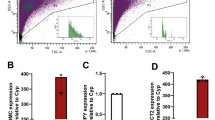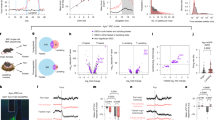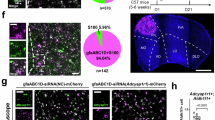Abstract
Pituitary adenylate cyclase-activating polypeptide (PACAP) and the proopiomelanocortin (POMC)-derived peptide, α-melanocyte-stimulating hormone (α-MSH), exert anorexigenic activities. While α-MSH is known to inhibit food intake and stimulate catabolism via activation of the central melanocortin-receptor MC4-R, little is known regarding the mechanism by which PACAP inhibits food consumption. We have recently found that, in the arcuate nucleus of the hypothalamus, a high proportion of POMC neurons express PACAP receptors. This observation led us to investigate whether PACAP may inhibit food intake through a POMC-dependent mechanism. In mice deprived of food for 18 h, intracerebroventricular administration of PACAP significantly reduced food intake after 30 min, and this effect was reversed by the PACAP antagonist PACAP6-38. In contrast, vasoactive intestinal polypeptide did not affect feeding behavior. Pretreatment with the MC3-R/MC4-R antagonist SHU9119 significantly reduced the effect of PACAP on food consumption. Central administration of PACAP induced c-Fos mRNA expression and increased the proportion of POMC neuron-expressing c-Fos mRNA in the arcuate nucleus. Furthermore, PACAP provoked an increase in POMC and MC4-R mRNA expression in the hypothalamus, while MC3-R mRNA level was not affected. POMC mRNA level in the arcuate nucleus of PACAP-specific receptor (PAC1-R) knock-out mice was reduced as compared with wild-type animals. Finally, i.c.v. injection of PACAP provoked a significant increase in plasma glucose level. Altogether, these results indicate that PACAP, acting through PAC1-R, may inhibit food intake via a melanocortin-dependent pathway. These data also suggest a central action of PACAP in the control of glucose metabolism.
Similar content being viewed by others
Log in or create a free account to read this content
Gain free access to this article, as well as selected content from this journal and more on nature.com
or
References
Banks WA, Kastin AJ, Komaki G, Arimura A (1993). Passage of pituitary adenylate cyclase activating polypeptide 1–27 and pituitary adenylate cyclase activating polypeptide 1–38 across the blood brain barrier. J Pharmacol Exp Ther 267: 690–696.
Berthoud HR (2002). Multiple neural systems controlling food intake and body weight. Neurosci Biobehav Rev 26: 393–428.
Birk S, Sitarz JT, Petersen KA, Oturai PS, Kruuse C, Fahrenkrug J et al (2007). The effect of intravenous PACAP38 on cerebral hemodynamics in healthy volunteers. Regul Pept 140: 185–191.
Borba JC, Henze IP, Silveira MS, Kubrusly RC, Gardino PF, de Mello MC et al (2005). Pituitary adenylate cyclase-activating polypeptide (PACAP) can act as determinant of the tyrosine hydroxylase phenotype of dopaminergic cells during retina development. Brain Res Dev 156: 193–201.
Bourgault S, Vaudry D, Botia B, Couvineau A, Laburthe M, Vaudry H et al (2008). Novel stable PACAP analogs with potent activity toward the PAC1 receptor. Peptides 29: 919–932.
Butler AA, Kesterson RA, Khong K, Cullen MJ, Pelleymounter MA, Dekoning J et al (2000). A unique metabolic syndrome causes obesity in the melanocortin-3 receptor-deficient mouse. Endocrinology 141: 3518–3521.
Chance WT, Thompson H, Thomas I, Fischer JE (1995). Anorectic and neurochemical effects of pituitary adenylate cyclase activating polypeptide in rats. Peptides 16: 1511–1516.
Chartrel N, Tonon MC, Vaudry H, Conlon JM (1991). Primary structure of frog pituitary adenylate cyclase-activating polypeptide (PACAP) and effects of ovine PACAP on frog pituitary. Endocrinology 129: 3367–3371.
Chen AS, Marsh DJ, Trumbauer ME, Frazier EG, Guan XM, Yu H et al (2000). Inactivation of the mouse melanocortin-3 receptor results in increased fat mass and reduced lean body mass. Nat Genet 26: 97–102.
Chomczynski P, Sacchi N (1987). Single-step method of RNA isolation by acid guanidinium thiocyanate-phenol-chloroform extraction. Anal Biochem 162: 156–159.
Cummings DE, Schwartz MW (2000). Melanocortins and body weight: a tale of two receptors. Nat Genet 26: 8–9.
Do Rego JC, Orta MH, Leprince J, Tonon MC, Vaudry H, Costentin J (2007). Pharmacological characterization of the receptor mediating the anorexigenic action of the octadecaneuropeptide: evidence for an endozepinergic tone regulating food intake. Neurospychopharmacology 32: 1641–1648.
Fan W, Boston BA, Kesterson RA, Hruby VJ, Cone RD (1997). Role of melanocortinergic neurons in feeding and the agouti obesity syndrome. Nature 385: 165–168.
Fan W, Dinulescu DM, Butler AA, Zhou J, Marks DL, Cone RD (2000). The central melanocortin system can directly regulate serum insulin levels. Endocrinology 141: 3072–3079.
Fichna J, Janecka A, Piestrzeniewicz M, Costentin J, Do Rego JC (2007). Antidepressant-like effect of endomorphin-1 and endomorphin-2 in mice. Neuropsychopharmacology 32: 813–821.
Fukuhara C, Suzuki N, Matsumoto Y, Nakayama Y, Aoki K, Tsujimoto G et al (1997). Day-night variation of pituitary adenylate cyclase-activating polypeptide (PACAP) level in the rat suprachiasmatic nucleus. Neurosci Lett 229: 49–52.
Gonzalez BJ, Basille M, Vaudry D, Fournier A, Vaudry H (1997). Pituitary adenylate cyclase-activating polypeptide promotes cell survival and neurite outgrowth in rat cerebellar neuroblasts. Neuroscience 78: 419–430.
Haley TJ, McCormick WG (1957). Pharmacological effects produced by intracerebral injection of drugs in the conscious mouse. Br J Pharmacol Chemother 12: 12–15.
Hannibal J, Mikkelsen JD, Clausen H, Holst JJ, Wulff BS, Fahrenkrug J (1995). Gene expression of pituitary adenylate cyclase activating polypeptide (PACAP) in the rat hypothalamus. Regul Pept 55: 133–148.
Hezareh M, Schlegel W, Rawlings SR (1996). PACAP and VIP stimulate Ca2+ oscillations in rat gonadotrophs through the PACAP/VIP type 1 receptor (PVR1) linked to a pertussis toxin-insensitive G-protein and the activation of phospholipase C-β. J Neuroendocrinol 8: 367–374.
Hotta M, Shibasaki T, Yamauchi N, Ohno H, Benoit R, Ling N et al. (1991). The effects of chronic central administration of corticotropin-releasing factor on food intake, body weight, and hypothalamic-pituitary-adrenocortical hormones. Life Sci 48: 1483–1491.
Huszar D, Lynch CA, Fairchild-Huntress V, Dunmore JH, Fang Q, Berkemeier LR et al (1997). Targeted disruption of the melanocortin-4 receptor results in obesity in mice. Cell 88: 131–141.
Ishihara T, Shigemoto R, Mori K, Takahashi K, Nagata S (1992). Functional expression and tissue distribution of a novel receptor for vasoactive intestinal polypeptide. Neuron 8: 811–819.
Jamen F, Persson K, Bertrand G, Rodriguez-Henche N, Puech R, Bockaert J et al (2000). PAC1 receptor-deficient mice display impaired insulinotropic response to glucose and reduced glucose tolerance. J Clin Invest 105: 1307–1315.
Jégou S, Cone RD, Eberlé AN, Vaudry H (2006). Melanocortins. In: Kastin AJ (ed). Handbook of Biologically Active Peptides. Elsevier: New York. pp 709–716.
Leboulenger F, Delarue C, Belanger A, Perroteau I, Netchitailo P, Leroux P et al (1982). Direct radioimmunoassay for plasma corticosterone and aldosterone in frog. I. Validation of the methods and evidence for daily rhythms in a natural environment. Gen Comp Endocrinol 46: 521–532.
Li G, Mobbs CV, Scarpace PJ (2003). Central pro-opiomelanocortin gene delivery results in hypophagia, reduced visceral adiposity, and improved insulin sensitivity in genetically obese Zucker rats. Diabetes 52: 1951–1957.
Li G, Zhang Y, Wilsey JT, Scarpace PJ (2005). Hypothalamic pro-opiomelanocortin gene delivery ameliorates obesity and glucose intolerance in aged rats. Diabetologia 48: 2376–2385.
Lutz EM, Sheward WJ, West KM, Morrow JA, Fink G, Harmar AJ (1993). The VIP2 receptor: molecular characterisation of a cDNA encoding a novel receptor for vasoactive intestinal peptide. FEBS Lett 334: 3–8.
Masuo Y, Suzuki N, Matsumoto H, Tokito F, Matsumoto Y, Tsuda M et al (1993). Regional distribution of pituitary adenylate cyclase activating polypeptide (PACAP) in the rat central nervous system as determined by sandwich-enzyme immunoassay. Brain Res 602: 57–63.
Matsuda K, Maruyama K, Miura T, Uchiyama M, Shioda S (2005). Anorexigenic action of pituitary adenylate cyclase-activating polypeptide (PACAP) in the goldfish: feeding-induced changes in the expression of mRNAs for PACAP and its receptors in the brain, and locomotor response to central injection. Neurosci Lett 386: 9–13.
Miyata A, Arimura A, Dahl RR, Minamino N, Uehara A, Jiang L et al (1989). Isolation of a novel 38 residue-hypothalamic polypeptide which stimulates adenylate cyclase in pituitary cells. Biochem Biophys Res Commun 164: 567–574.
Miyata A, Jiang L, Dahl RD, Kitada C, Kubo K, Fujino M et al (1990). Isolation of a neuropeptide corresponding to the N-terminal 27 residues of the pituitary adenylate cyclase activating polypeptide with 38 residues (PACAP38). Biochem Biophys Res Commun 170: 643–648.
Mizuno TM, Kelley KA, Pasinetti GM, Roberts JL, Mobbs CV (2003). Transgenic neuronal expression of proopiomelanocortin attenuates hyperphagic response to fasting and reverses metabolic impairments in leptin-deficient obese mice. Diabetes 52: 2675–2683.
Mizuno Y, Kondo K, Terashima Y, Arima H, Murase T, Oiso Y (1998). Anorectic effect of pituitary adenylate cyclase activating polypeptide (PACAP) in rats: lack of evidence for involvement of hypothalamic neuropeptide gene expression. J Neuroendocrinol 10: 611–616.
Morley JE, Horowitz M, Morley PM, Flood JF (1992). Pituitary adenylate cyclase activating polypeptide (PACAP) reduces food intake in mice. Peptides 13: 1133–1135.
Mounien L, Bizet P, Boutelet I, Gourcerol G, Fournier A, Vaudry H et al (2006a). Pituitary adenylate cyclase activating polypeptide directly modulates the activity of proopiomelanocortin neurons in the rat arcuate nucleus. Neuroscience 143: 155–163.
Mounien L, Bizet P, Boutelet I, Vaudry H, Jégou S (2006b). Expression of melanocortin MC3 and MC4 receptor mRNAs by neuropeptide Y neurons in the rat arcuate nucleus. Neuroendocrinology 82: 164–170.
Obici S, Feng Z, Tan J, Liu L, Karkanias G, Rossetti L (2001). Central melanocortin receptors regulate insulin action. J Clin Invest 108: 1079–1085.
Ozawa M, Aono M, Moriga M (1999). Central effects of pituitary adenylate cyclase activating polypeptide (PACAP) on gastric motility and emptying in rats. Dig Dis Sci 44: 735–743.
Piggins HD, Stamp JA, Burns J, Rusak B, Semba K (1996). Distribution of pituitary adenylate cyclase activating polypeptide (PACAP) immunoreactivity in the hypothalamus and extended amygdala of the rat. J Comp Neurol 376: 278–294.
Qu D, Ludwig DS, Gammeltoft S, Piper M, Pelleymounter MA, Cullen MJ et al (1996). A role for melanin-concentrating hormone in the central regulation of feeding behaviour. Nature 380: 243–247.
Rowland NE (1998). Brain mechanisms of mammalian fluid homeostasis: insights from use of immediate early gene mapping. Neurosci Biobehav Rev 23: 49–63.
Sakurai T, Amemiya A, Ishii M, Matsuzaki I, Chemelli RM, Tanaka H et al (1998). Orexins and orexin receptors: a family of hypothalamic neuropeptides and G protein-coupled receptors that regulate feeding behavior. Cell 92: 573–585.
Schwartz MW, Seely RJ, Woods SC, Weigle DS, Campfield LA, Burn P et al (1997). Leptin increases hypothalamic pro-opiomelanocortin mRNA expression in the rostral arcuate nucleus. Diabetes 46: 2119–2123.
Sekiguchi Y, Kasai K, Hasegawa K, Suzuki Y, Shimoda S (1994). Glycogenolytic activity of pituitary adenylate cyclase activating polypeptide (PACAP) in vivo and in vitro. Life Sci 55: 1219–1228.
Sherwood NM, Krueckl SL, McRory JE (2000). The origin and function of the pituitary adenylate cyclase-activating polypeptide (PACAP)/glucagon superfamily. Endocr Rev 21: 619–670.
Sheward WJ, Lutz EM, Harmar AJ (1995). The distribution of vasoactive intestinal peptide2 receptor messenger RNA in the rat brain and pituitary gland as assessed by in situ hybridization. Neuroscience 67: 409–418.
Shioda S, Shuto Y, Somogyvari-Vigh A, Legradi G, Onda H, Coy DH et al (1997). Localization and gene expression of the receptor for pituitary adenylate cyclase-activating polypeptide in the rat brain. Neurosci Res 28: 345–354.
Spengler D, Waeber C, Pantaloni C, Holsboer F, Bockaert J, Seeburg PH et al (1993). Differential signal transduction by five splice variants of the PACAP receptor. Nature 365: 170–175.
Tachibana T, Saito ES, Takahashi H, Saito S, Tomonaga S, Boswell T et al (2004). Anorexigenic effects of pituitary adenylate cyclase-activating polypeptide and vasoactive intestinal peptide in the chick brain are mediated by corticotrophin-releasing factor. Regul Pept 120: 99–105.
Tohei A, Matsuzaki M, Kogo H (2001). Antagonist of pituitary adenylate cyclase activating polypeptide suppresses prolactin secretion without changing the activity of dopamine neurons in lactating rats. Neuroendocrinology 73: 68–74.
Usdin TB, Bonner TI, Mezey E (1994). Two receptors for vasoactive intestinal polypeptide with similar specificity and complementary distributions. Endocrinology 135: 2662–2680.
Vaudry D, Gonzalez BJ, Basille M, Yon L, Fournier A, Vaudry H (2000). Pituitary adenylate cyclase-activating polypeptide and its receptors: from structure to functions. Pharmacol Rev 52: 269–324.
White JD, Kershaw M (1989). Increased hypothalamic neuropeptide Y expression following food deprivation. Mol Cell Neurosci 1: 41–48.
Williams DL, Grill HJ, Kaplan JM (2004). Food deprivation after treatment blocks the multiple-day hyperphagic response to SHU9119 administration. Brain Res 996: 180–186.
Yaswen L, Diehl N, Brennan MB, Hochgeschwender U (1999). Obesity in the mouse model of pro-opiomelanocortin deficiency responds to peripheral melanocortin. Nat Med 5: 1066–1070.
Acknowledgements
This work was supported by INSERM (U413), CNRS (FRE 2735), the European Institute for Peptide Research (IFRMP 23), the Regional Platform for Cell Imaging, and the Conseil Régional de Haute-Normandie. HV is an affiliate professor at the INRS − Institut Armand-Frappier (Montréal, Canada).
Author information
Authors and Affiliations
Corresponding authors
Additional information
DISCLOSURE/CONFLICT OF INTEREST
The authors declare that except for income received from their primary employer, no financial support or compensation has been received from any individual or corporate entity over the past 3 years for research or professional service and there are no personal financial holdings that could be perceived as constituting a potential conflict of interest.
Rights and permissions
About this article
Cite this article
Mounien, L., Do Rego, JC., Bizet, P. et al. Pituitary Adenylate Cyclase-Activating Polypeptide Inhibits Food Intake in Mice Through Activation of the Hypothalamic Melanocortin System. Neuropsychopharmacol 34, 424–435 (2009). https://doi.org/10.1038/npp.2008.73
Received:
Revised:
Accepted:
Published:
Issue date:
DOI: https://doi.org/10.1038/npp.2008.73
Keywords
This article is cited by
-
Ghrelin inhibits autonomic response to gastric distension in rats by acting on vagal pathway
Scientific Reports (2020)
-
Splice-specific deficiency of the PTSD-associated gene PAC1 leads to a paradoxical age-dependent stress behavior
Scientific Reports (2020)
-
Pituitary Adenylate Cyclase-Activating Polypeptide in the Ventromedial Hypothalamus Is Responsible for Food Intake Behavior by Modulating the Expression of Agouti-Related Peptide in Mice
Molecular Neurobiology (2020)
-
PACAP38 and PAC1 receptor blockade: a new target for headache?
The Journal of Headache and Pain (2018)
-
The Melanocortin Signal System of the Hypothalamus and Its Functional State in Type 2 Diabetes Mellitus and Metabolic Syndrome
Neuroscience and Behavioral Physiology (2017)



